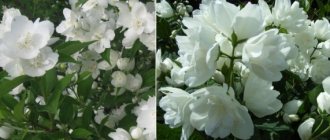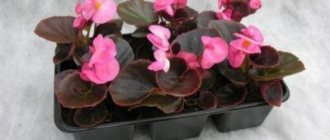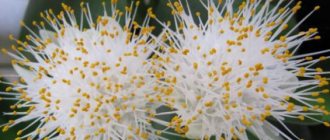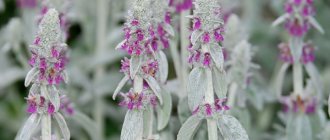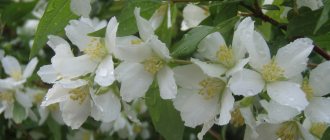We firmly associate the Jasmine flower with tea and aromatic garden shrubs (garden jasmine).
But, in fact, jasmine has nothing to do with the shrubs that grow in the gardens of central Russia. Mock orange grows in open ground, which is similar to jasmine only in the aroma of the flowers; otherwise, these are completely different plants belonging to different families. Real jasmine is an evergreen vine or shrub, which, due to its demanding and capricious nature, simply will not survive our winter and is grown here exclusively as a potted crop, which is the pride of any gardener.
Buy Jasmine seeds =>>
Choosing the optimal site for planting
Fluffy, crown or small-leaved jasmine can often be found in country gardens and cottages. In prevailing cases, jasmine is planted in the spring season, regardless of which subspecies has been chosen at the moment.
For healthy growth and formation of the plant, you should familiarize yourself with the main rules for planting and maintaining it:
- For rich flowering and impressive appearance, jasmine should be planted in a place protected from drafts, as they adversely affect the growth of this shrub. For jasmine, a well-lit place with plenty of direct sunlight will be more suitable.
- This shrub is best planted among flowers that are lilac or bright blue. For example, next to lavender or spur, jasmine will look very harmonious.
- Experts advise planting in the spring, however, this process can be done in the fall.
Top varieties for regions
The Moscow region and Siberia are regions with cold winters. Not every plant is able to survive in such conditions; Siberian frosts are especially severe. However, mock orange, unlike jasmine, is more resistant to low temperatures. Both foreign and Russian selections have varieties with increased resistance to frost.
We recommend reading about when and how to plant jasmine.
For the Moscow region
For wet winters, with frequently changing temperatures due to cyclones, varieties with woody shoots and a wide crown are suitable.
Popular varieties in the region:
- Manto de'Ermine (Ermine mantle) - semi-double, white, with a strawberry aroma;
- Snow avalanche - snow-white inflorescences with a berry aroma, lush flowering;
- Elbrus - white terry brushes of flowers with a diameter of 4.5 cm;
- Dame Blanche - semi-double, with a delicate aroma, snow-white;
- Dwarf - does not bloom, decorative, glossy foliage of dark green color. Used as borders.
Important! To increase plant endurance in the fall in 1.5 months. Before the first frost, phosphorus fertilizers are applied to the tree trunk circle for digging.
For Siberia
In Siberia, winter temperatures are much lower than in the Moscow region, but the frost is dry. The bushes need pre-winter cover of the tree trunk circle with a layer of mulch and spruce branches. When snow falls, it is raked over the covering material, using it as an additional thermal cushion.
Suitable varieties for growing:
- Alabaster - large, double, fragrant, snow-white flowers;
- Belle Etoile - the bud is pink at the base, and the petals are white, has a jasmine aroma;
- Airborne - simple cream-colored flowers with a berry scent;
- Aurea - beige petals, yellow foliage;
- Lavina is a weeping type of shrub, small white flowers with a strawberry scent;
- Snow storm - snow-white inflorescences cover the entire bush with a dense cloud;
- Pompom - terry baskets are collected into large dense balls;
- Pearl - shoots with a red tint to the bark contrast with white flowers and bright green foliage;
- Gnome - dwarf, small-leaved, non-flowering. Decorative glossy yellow foliage.
Both plants are beautiful in their bloom. In our latitudes, mock orange is preferable to tender heat-loving jasmine. This crop can be grown in a winter garden or selected as an indoor variety.
Correct disembarkation process
For the best growth of jasmine, it is necessary not only to carefully select the soil, but also to the planting process itself.
The photo shows the step-by-step procedure for planting it correctly:
- And although the shrub can grow successfully in any soil, it is better to choose soil that contains nutrients.
- Since the roots respond negatively to excess moisture, the plot of land that is located on a slight elevation should be chosen.
- Then you need to pour sand mixed with small pebbles into the hole. This layer will act as drainage. In the spring, you can add 40 g of nitrophosphate to the hole so that the plant grows faster.
- After planting the bush and compacting the soil, the plant is watered.
Diseases and pests
Most of the problems with jasmine are associated with violation of the rules of agricultural technology on the part of the gardener. Reviewing the watering regime and applying fertilizing helps solve most problems.
Among the pests that threaten the plant are:
- aphid;
- spider mite;
- whitefly
Regular treatments with insecticides will help in pest control.
Mandatory care
In order for the garden to be decorated with fluffy, delightful jasmine, the plant requires regular care, namely:
- The first feeding must be done a year after planting the plant.
- For garden jasmine, manure and humus are necessary organic fertilizers. It should be borne in mind that fertilizing is carried out exclusively in water-diluted form in order to avoid burning of the root system.
- Emerging pruning should be carried out in the spring - during the vegetative state of the shrub.
- Long branches are cut off, and short ones are reduced by half. Every year, bushes are examined and damaged and diseased branches are removed.
The correct maintenance of home jasmine consists of bright, diffused lighting, consistent introduction of fertilizing into the soil, creation of high humidity, a six-month dormant period, and annual replanting of young and adult materials.
We recommend reading:
- Flowers for a flower bed blooming all summer until autumn: photo and name
- Fern and its types: characteristics, features and propagation tips
- Autumn flowers in the garden: photos and names
The temperature regime is no less important, because if the flower is in a too warm room, it will grow remarkably and increase its green mass.
However, such a plant will not bloom. Only systematic ventilation will help correct such an incident.
Botanical description
It should be noted that jasmine and mock orange are two different plants. The first belongs to the Oleaceae family, the second to the Hydrangeaceae family. However, due to its similarity with the fragrant plant, mock orange is called garden jasmine.
Jasmine
Jasminum is the Latin name for an evergreen shrub with delicate flowers that have a delicate, pleasant aroma. The plant in nature prefers subtropics, temperate climates; several species grow on mountain slopes, high above sea level.
These are shrubs and subshrubs, upright or liana-like, climbing. Green or brown shoots are thin and flexible. Foliage with blades simple, odd-pinnate or opposite. The shape can be oval-round or elongated with a sharp tip, the surface is often glossy.
The flowering period, depending on the species, is winter or summer, but for all representatives it is long . Flowers with tubular petals, star-shaped or simple. Mostly solitary, growing in small groups, “sit” on a long peduncle. Color:
- white;
- yellow;
- all shades of pink;
- purple.
At the end of flowering it forms a multi-seeded fruit.
Did you know? Residents of the Mediterranean call the aroma of jasmine the King of Smells. It is believed to stimulate the brain, provoke creative ideas and maintain a positive attitude.
Kinds
Due to its heat-loving nature, jasmine in our climate is often grown as a greenhouse or potted crop. Only a few varieties are grown in open ground, and only in the south of the country. In addition, some species have medicinal properties; tea is prepared from the petals of many plants. The following are the most famous cultivated species.
Chinese
The shrub or vine grows up to 10 m . The bright green foliage is oval-round in shape with a sharp tip. There is a clear lighter vein in the center. The surface of the plate is glossy. The flowers are five-petaled, snow-white, 1.5–2 cm in diameter. The petals are turned upside down, like a tube.
Jasmine sambac or Arabic
Bush up to 3 m, climbing or upright. The foliage has a smooth surface and has an edge at the base. The shape of the plates is ovoid up to 12 cm in length. Flowers are collected in groups, diameter up to 3 cm, number of white petals - 5–9 pcs. Feature: during the day the petals are closed, opening after 6 pm.
Find out more about the description of Sambac jasmine.
Known cultivars:
- Mograw or Maid of Orleans;
- Beauty of India;
- Mali Chat;
- Rose jasmine or Grand Duke of Tuscany;
- Arabian knights.
Lerata
An adult specimen reaches a height of 3.5–4 m. The shoots are long and thin, green in color. The foliage is bright green with a glossy surface. The shape of the plates is elongated, lanceolate. The flowers are white up to 1.2 cm in diameter. It has an interesting aroma with a hint of mint .
Multifloral
The plant is from 1 to 10 m in height. It is distinguished by winter flowering - in February . Moderately frost-resistant, can withstand temperatures down to -12 degrees. During flowering, this species forms racemose, loose inflorescences. The petals are arranged in a star pattern and are white in color.
Drug
White or officinalis jasmine is a climbing plant . Its shoots are long, angular and thin. The bark is grey-green. White fragrant flowers are located on long peduncles. The foliage is opposite, in pairs, with a smooth surface.
Did you know? The plant is used in pharmacology as a raw material for the manufacture of anti-inflammatory and antiseptic drugs.
The thinnest
A winter-flowering vine with weak branching and up to 2 m in length. Umbrella inflorescences appear in January. The pink buds become snow-white when they bloom. The flower shape is narrow-tubular. The species has a very rich aroma, for which, according to one version, it got its name .
Jasmine Italian yellow
Creeping appearance . The shrub has a lush, rounded shape, with lanceolate, glossy leaves. Blooms all summer. The petals of small baskets are bright yellow. The rarest variety of the species is considered to be Auriculatum - it has white flowers with satin petals with a very delicate aroma.
Pink Bisa
May jasmine with long shoots. The plant is liana-shaped, branches are 2 m long. The foliage, pubescent on both sides, is lanceolate in shape. The plates are painted dark green. Depending on the variety, the color of the flowers ranges from pale pink to bright crimson .
Yellow (shrub)
Low bush up to 1 m tall . The shoots are knotty, the bark is green. The leaves are narrow, elliptical, trifoliate. Plate with a blunt end, dark green. Flowering period - May - July. Tubular-type flowers are collected in loose umbrellas. The petals are bright yellow.
Jasmine holoflora
The naked jasmine plant comes in two types: upright and creeping . The shoots are not pubescent, crooked and weak. The bark is gray-green.
Important! It is recommended to provide a creeping bush with support or plant it near a wall or a lattice fence. Weak branches often break under the weight of flowers.
Opposite leaves are ovoid. Flowers are solitary, up to 2.5 cm in diameter. The color of the petals is yellow.
Grandiflora
A bush with a spherical crown 80–100 cm high. The shoots are drooping, thick. The foliage is compound pinnate and not arranged in pairs. The plates are large, up to 11 cm in length and 5.5 cm in width. Flowers are collected in 3–9 pieces. in inflorescences on a long peduncle. The bud is pink or red, with a snow-white corolla in the middle .
Chubushnik
Deciduous or semi-deciduous shrub, Latin name Philadelphus. The shoots are located opposite, covered with thin gray bark.
Leaves with edges on the underside vary in shape depending on the species:
- ovoid;
- elongated oval;
- wedge-shaped;
- rounded.
Photo of jasmine
Medicinal properties and contraindications
Jasmine is actively used in traditional medicine recipes. Among its useful qualities the following are noted:
- improvement of lactation during breastfeeding in women;
- reduces discomfort during menstruation;
- has a pronounced analgesic property;
- helps rapid tissue regeneration;
- clears the lungs of phlegm;
- improves metabolism.
But jasmine also has contraindications for use. It is strictly forbidden to take jasmine-based preparations:
- during pregnancy;
- for chronic kidney diseases;
- with low blood pressure (hypotension);
- in the presence of acute allergic reactions.
Reproduction methods
You can propagate garden jasmine of double varieties in one of the following ways:
Seed propagation is quite labor-intensive and requires a long waiting time. Only after 6 – 7 years will the plant be pleased with abundant, lush flowering. For layering, the strongest, strongest shoots are selected, which are fixed in a shallow trench around the bush at the base of the first bud. Shoots for rooting are sprinkled with peat and moistened. During the season they are hilled up twice and cared for in the standard way. With the arrival of autumn, young seedlings are separated from the mother bush and planted in separate beds for growing.
For cuttings in June, cut branches 10 cm long along an oblique line. Planting material is planted in a greenhouse, after keeping them in a root-stimulating solution. Seedling care is standard: moistening, airing and hardening after rooting. Strong, healthy seedlings are planted in a permanent place only the next year.
Possible problems during cultivation
Jasmine is quite easy to grow indoors. To do this, you need to choose a spacious room, excluding the bedroom, in which it is impossible to create sufficient ventilation. A strong aroma can cause headaches.
It is advisable to maintain an average temperature, but being in direct sunlight is not critical unless it is permanent, otherwise it may dry out. The higher the air temperature, the more abundant watering and spraying should be to prevent the soil from drying out.
In the first years, jasmine needs regular replanting; after the flower reaches its size, it requires this procedure less often (once every 3 years). The soil must be specially fertilized and fed. Like all plants, the flower loves pruning and pinching, after which it even visually transforms.
Despite its unpretentiousness, jasmine leaves sometimes turn yellow and there is no flowering. The first problem can be solved by changing the watering. The water needs to be settled, because hard liquid has a detrimental effect on the plant. Also, the watering schedule should not be violated. Carefully ensure that the sun's rays, if possible, do not fall on the crown - this also leads to yellowing and falling of the foliage. The second problem is solved by changing the soil. If the wrong composition is selected, which has a neutral or alkaline environment, flowers will never appear. At the same time, the bush itself will look great. In specialized stores you can purchase acidic soil, which promotes jasmine flowering.

